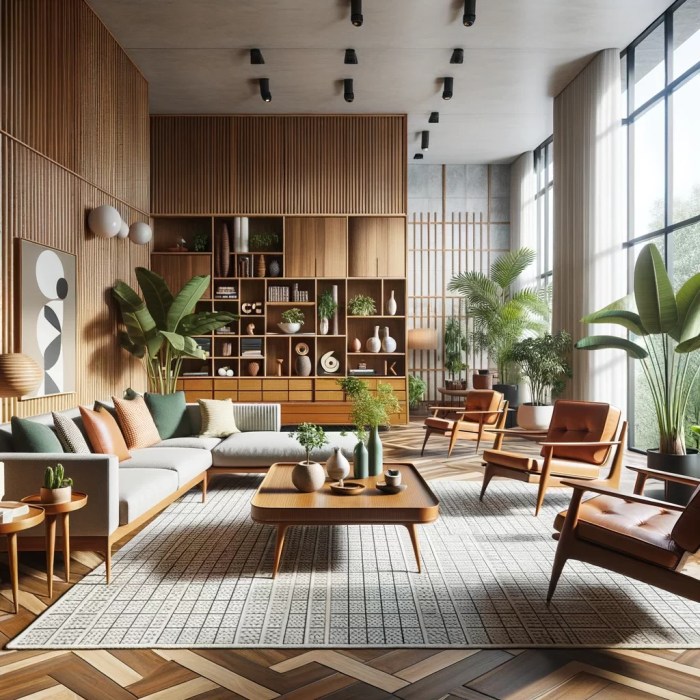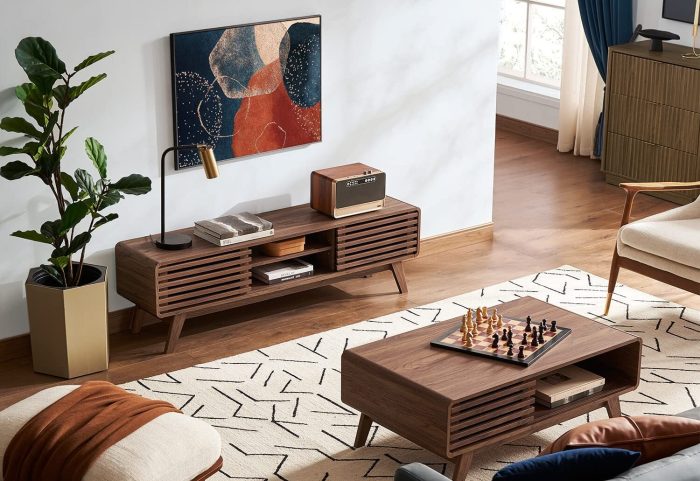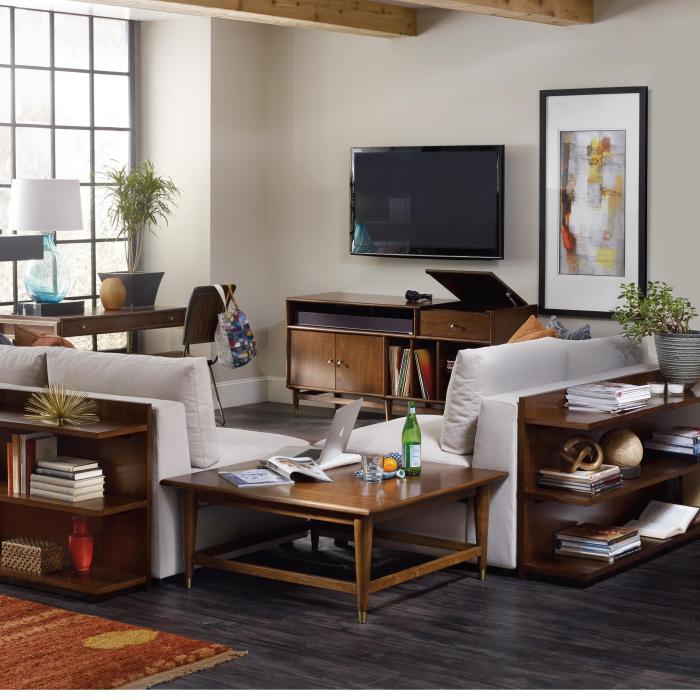Mid century modern furniture, a style synonymous with clean lines and functional design, continues to captivate homeowners and designers alike. Its enduring appeal stems from a unique blend of minimalist aesthetics and handcrafted quality, reflecting a post-war era of optimism and innovation. This style, characterized by organic shapes, tapered legs, and the use of natural materials like teak and walnut, offers a timeless elegance that transcends fleeting trends.

We’ll explore the key features, iconic pieces, and lasting influence of this beloved design movement.

The post-war economic boom fueled the popularity of mid-century modern design, making quality furniture more accessible to a wider population. This accessibility, combined with the inherent elegance and functionality of the pieces, cemented its place in design history. From iconic chairs like the Eames Lounge Chair to the sleek lines of credenzas and coffee tables, the era produced a wealth of designs that are still highly sought after today.
Mid-Century Modern (MCM) furniture, a design movement spanning roughly from the late 1930s to the mid-1960s, continues to captivate design enthusiasts worldwide. Its clean lines, organic forms, and emphasis on functionality represent a unique blend of artistic expression and practical living. This comprehensive guide delves into the history, key characteristics, prominent designers, and enduring appeal of Mid-Century Modern furniture, providing you with a detailed understanding of this iconic style.
The History and Origins of Mid-Century Modern
The rise of Mid-Century Modern design wasn’t a sudden event; it was a culmination of various socio-cultural shifts. Post-World War II, there was a surge in optimism and a desire for a fresh start. Mass production techniques became more sophisticated, making quality design accessible to a wider population. This era saw a rejection of overly ornate styles of the past, favoring clean lines and functionality.
Influenced by the Bauhaus movement and its emphasis on form following function, MCM embraced simplicity and minimalism, creating pieces that were both beautiful and practical.
Key Influences on Mid-Century Modern Design:
- Bauhaus: The German art school’s focus on functionality and geometric forms heavily influenced MCM aesthetics.
- Scandinavian Design: The minimalist and nature-inspired designs of Scandinavian countries contributed to the organic shapes and use of natural materials.
- Modernism: The broader modernist movement’s emphasis on simplicity, functionality, and clean lines played a crucial role in shaping MCM.
Defining Characteristics of Mid-Century Modern Furniture
Several key characteristics distinguish Mid-Century Modern furniture from other design styles. These features, often present in combination, create the unique aesthetic of the period:
Distinctive Design Elements:
- Clean Lines and Simple Forms: MCM furniture avoids excessive ornamentation, opting for streamlined silhouettes and uncluttered designs.
- Organic Shapes: Curved lines and organic forms, inspired by nature, are frequently incorporated, creating a sense of fluidity and grace.
- Functionality and Ergonomics: Design prioritized comfort and practicality. Pieces were designed to be both aesthetically pleasing and user-friendly.
- Use of New Materials: The era saw the introduction of new materials like plywood, plastic laminates (like Formica), and molded fiberglass, allowing for innovative designs and mass production.
- Tapered Legs: Many MCM pieces feature tapered legs, adding a sense of lightness and elegance.
- Minimalist Color Palettes: Neutral tones like beige, gray, and brown were popular, often complemented by pops of brighter colors.
Iconic Mid-Century Modern Designers and Brands
Many talented designers shaped the Mid-Century Modern landscape. Their innovative creations continue to be highly sought after by collectors and design enthusiasts:

Notable Designers and Their Contributions:
- Charles and Ray Eames: Known for their innovative use of plywood and molded plastic, their designs like the Eames Lounge Chair and Eames Molded Plastic Chairs are iconic.
- Eero Saarinen: His Tulip chair, with its pedestal base, is a masterpiece of modern design, embodying simplicity and elegance.
- Arne Jacobsen: A Danish designer known for his Egg Chair and Swan Chair, both showcasing organic forms and sophisticated comfort.
- Paul McCobb: An American designer whose Planner Group exemplifies the functional and modular approach of MCM.
- George Nelson: Known for his innovative use of materials and his iconic ball clock.
Beyond individual designers, several brands played a significant role in popularizing MCM furniture. These included Herman Miller, Knoll, and Knoll International, known for their high-quality craftsmanship and collaborations with leading designers.
The Enduring Appeal of Mid-Century Modern Furniture
The continued popularity of Mid-Century Modern furniture is a testament to its timeless design. Its clean lines, functionality, and organic forms transcend fleeting trends, making it a style that remains relevant and desirable decades later.
Reasons for its Lasting Popularity:
- Timeless Aesthetics: The simple yet elegant designs age gracefully, avoiding the dated look of many other styles.
- Versatility: MCM pieces can be easily incorporated into various interior design styles, from minimalist to eclectic.
- Quality Craftsmanship: Many MCM pieces were built to last, using high-quality materials and construction techniques.
- Collectibility: Original pieces by renowned designers are highly sought after by collectors, increasing their value over time.
- Sustainability: The emphasis on natural materials and durable construction aligns with contemporary sustainability values.
Identifying Authentic Mid-Century Modern Furniture
With the resurgence in popularity, many reproductions and imitations exist. Knowing how to identify authentic MCM pieces is crucial for discerning buyers:
Tips for Authentication:, Mid century modern furniture
- Maker’s Marks and Labels: Look for manufacturer’s marks, labels, or stamps indicating the maker and date of production.
- Construction Quality: Examine the quality of materials and craftsmanship. Authentic pieces often exhibit superior construction.
- Design Details: Pay close attention to the design details, comparing them to known examples of authentic pieces.
- Research: Consult books, online resources, and experts to verify the authenticity of a piece.
Mid-Century Modern Furniture Today: Trends and Influences
Today, Mid-Century Modern continues to inspire contemporary designers. Many modern pieces incorporate MCM elements, creating a blend of classic and contemporary styles.
Contemporary Interpretations:
- Reinterpretations of Iconic Designs: Modern designers often reinterpret classic MCM designs, updating them with new materials and techniques.
- Blending MCM with Other Styles: MCM is frequently blended with other styles, such as Scandinavian, industrial, or bohemian, creating unique and eclectic interiors.
- Sustainable and Eco-Friendly Materials: Modern interpretations often prioritize sustainable and eco-friendly materials, reflecting contemporary values.
Frequently Asked Questions (FAQ)
- Q: What is the difference between Mid-Century Modern and Modern furniture? A: While related, Mid-Century Modern is a specific period within the broader Modern movement, characterized by its organic shapes and post-war optimism.
- Q: How can I care for my Mid-Century Modern furniture? A: Regular dusting and cleaning with appropriate materials are key. For upholstered pieces, professional cleaning is recommended.
- Q: Where can I find authentic Mid-Century Modern furniture? A: Antique shops, online marketplaces, auction houses, and specialized furniture stores are good places to start.
- Q: How much does Mid-Century Modern furniture cost? A: Prices vary widely depending on the designer, condition, and rarity of the piece. Original pieces can be quite expensive.
- Q: How do I incorporate Mid-Century Modern furniture into my home? A: Start by selecting a few key pieces and building around them. Consider the color palette and overall style of your home.
Resources
- Pamono
-Online marketplace for vintage and contemporary design. - 1stDibs
-High-end online marketplace for antiques and design. - Museum of Modern Art (MoMA)
-Extensive collection of modern and contemporary design.
Call to Action: Mid Century Modern Furniture
Ready to embrace the timeless elegance of Mid-Century Modern furniture? Start exploring the vast array of options available and discover the perfect pieces to transform your living space. Browse our curated collection of authentic and reproduction MCM furniture today!
FAQ Corner
What materials are commonly used in mid-century modern furniture?
Common materials include teak, walnut, oak, and other hardwoods, often combined with upholstery fabrics like wool and leather.
How can I identify authentic mid-century modern furniture?
Look for hallmarks like tapered legs, clean lines, organic shapes, and the use of quality materials. Manufacturer’s marks and construction details can also be helpful in authentication.
Where can I find mid-century modern furniture?
Antique shops, flea markets, online marketplaces (like eBay), and dedicated vintage furniture stores are good places to start your search.
How do I care for mid-century modern furniture?
Regular dusting and occasional polishing with appropriate wood cleaners will help maintain the beauty of your furniture. Upholstery should be cleaned according to the manufacturer’s instructions.
